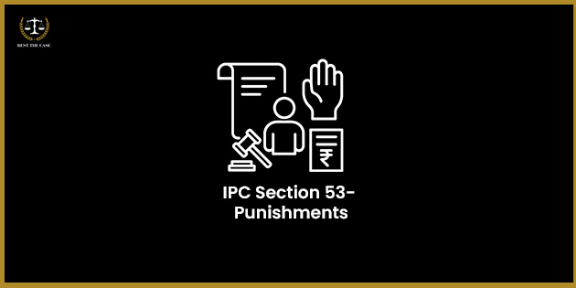
In criminal law, defining a crime is only one side of the justice system- the other is prescribing a suitable punishment. That’s where Section 53 of the Indian Penal Code (IPC) comes into play. It lists the types of punishments that courts can impose on offenders, depending on the severity and nature of the crime. This section forms the backbone of sentencing in India’s criminal justice system.
In this blog, we’ll explore:
- The legal definition of punishment under IPC Section 53
- A simplified breakdown of the different types of punishment
- Why these punishments matter in criminal sentencing
- Examples where each type of punishment is applied
- How does this section align with modern reforms and BNS updates
What is IPC Section 53?
Legal Definition:
Section 53 of the IPC reads:
The punishments to which offenders are liable under the provisions of this Code are:
- Death
- Imprisonment for life
- Imprisonment, which is of two descriptions: (i) Rigorous, i.e., with hard labour; (ii) Simple
- Forfeiture of property
- Fine
These are the five primary forms of punishment that courts can impose when someone is found guilty of an offence under the Indian Penal Code.
Simplified Explanation
Let’s break it down for better understanding:
- Death Penalty: The most extreme punishment, used only in the rarest of rare cases, such as terrorism, brutal murders, or crimes against the nation.
- Life Imprisonment: The convict is sentenced to spend the rest of their natural life in prison unless legally remitted by the government.
- Imprisonment (Rigorous or Simple):
- Rigorous imprisonment involves hard labor like breaking stones or cleaning prison premises.
- Simple imprisonment does not involve physical labor and is imposed for less serious offences like defamation or public nuisance.
- Forfeiture of Property: The convict’s property can be confiscated as a punitive and preventive measure. This is typically used in cases of sedition or terrorism.
- Fine: A monetary penalty, either alone or along with other punishments, depending on the severity of the crime.
Why is IPC Section 53 Important?
Section 53 sets the sentencing framework for all offences under the IPC. Once the guilt of an accused is established, this section helps the court decide how to penalise the offender while ensuring that the punishment is proportionate to the offence committed.
It plays a crucial role in:
- Maintaining uniformity in criminal sentencing
- Providing a legal basis for punishment types
- Giving judges the flexibility to choose from various punishments
- Serving as a deterrent against future crimes
- Supporting victim rights and reparation through fines or forfeiture
Illustrative Examples
Example 1: Death Penalty
In cases like terrorism (Section 121 – Waging war against the state) or brutal rape-murder cases under Section 376A IPC, the court may award the death penalty.
Example 2: Life Imprisonment
In a murder case under Section 302 IPC, the convict may be sentenced to life imprisonment if the court finds mitigating factors.
Example 3: Rigorous Imprisonment
For offences like causing grievous hurt (Section 325 IPC), courts often impose rigorous imprisonment with hard labor for several years.
Example 4: Simple Imprisonment
In a case of defamation (Section 500 IPC), the convict may be sentenced to simple imprisonment for up to two years or fined.
Example 5: Forfeiture of Property
Under Section 126 IPC (committing depredation on territories of foreign states at peace with India), forfeiture of property may be ordered.
Legal Context and Usage
Section 53 is not applied in isolation. It is referred to after conviction, and the specific punishment under this section is determined based on:
- The nature and gravity of the offence
- Mitigating and aggravating circumstances
- Prior criminal record of the offender
- Impact on the victim and society
- Provisions of procedural laws (like CrPC Sections 235 and 248)
This section works in tandem with sentencing provisions across the IPC- from theft to murder- allowing judges to choose the most appropriate punishment.
Relevance in Modern Context
With the advent of Bharatiya Nyaya Sanhita (BNS), Section 53's equivalent is Section 4, which continues to list these five basic punishments. While sentencing reforms are underway, India still follows the retributive and deterrent theory of punishment. However, with the growth of restorative justice, there is increasing debate on whether alternative sentencing (like community service or victim compensation) should be introduced formally.
Conclusion
IPC Section 53 serves as the sentencing cornerstone of Indian criminal law. It provides the essential legal tools for judges to impose punishments that are just, proportional, and in accordance with established legal principles. From the most serious crimes deserving death or life imprisonment to minor offences penalised with fines or simple imprisonment, this section ensures that justice is both served and seen to be served. In an evolving legal system, Section 53 remains a reminder of the balance between deterrence, reformation, and fairness, key pillars of India’s approach to criminal justice.
Frequently Asked Questions
Q1. What are the five punishments listed under IPC Section 53?
Section 53 lists: (1) Death, (2) Life Imprisonment, (3) Rigorous or Simple Imprisonment, (4) Forfeiture of Property, and (5) Fine.
Q2. What is the difference between rigorous and simple imprisonment?
Rigorous imprisonment involves hard labour during custody, while simple imprisonment does not require the convict to perform physical work.
Q3. Can a convict receive more than one type of punishment?
Yes, in many cases, a convict may receive both imprisonment and a fine, depending on the offence and sentencing guidelines.
Q4. Is life imprisonment always for the rest of the convict’s life?
Legally, life imprisonment means imprisonment for the natural life of the convict. However, remission policies may reduce the actual time served.
Q5. Has Section 53 been changed under the new BNS?
The concept remains the same. Section 4 of the Bharatiya Nyaya Sanhita, 2023 mirrors the punishment types listed in IPC Section 53, with minor updates aligning to the new code’s structure.






